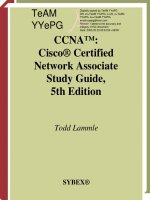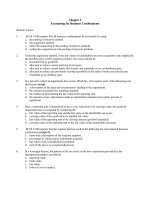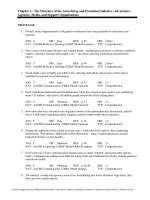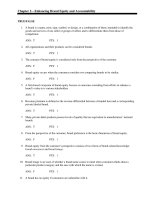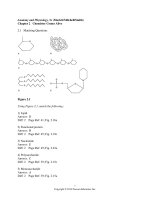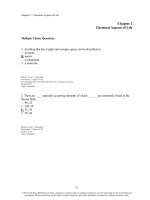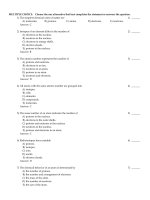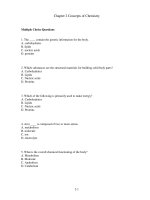Anatomy and physiology with integrated study guide 5th edition gunstream test bank
Bạn đang xem bản rút gọn của tài liệu. Xem và tải ngay bản đầy đủ của tài liệu tại đây (338.68 KB, 15 trang )
Chapter 2: - Chemical Aspects of Life
Chapter 2
Chemical Aspects of Life
Multiple Choice Questions
1. Anything that has weight and occupies space can be described as
A. an atom.
B. matter.
C. a compound.
D. a molecule.
Bloom's Level: 1. Remember
Gunstream - Chapter 02 #1
Learning Outcome: 02.01 Describe the basic structure of an atom.
Section 02.01
Topic: Chemistry
2. There are ____ naturally occurring elements of which ______ are commonly found in the
human body.
A. 96; 22
B. 104; 28
C. 92; 26
D. 58; 34
Bloom's Level: 1. Remember
Gunstream - Chapter 02 #2
Section 02.01
Topic: Chemistry
2-1
© 2013 by McGraw-Hill Education. This is proprietary material solely for authorized instructor use. Not authorized for sale or distribution in
any manner. This document may not be copied, scanned, duplicated, forwarded, distributed, or posted on a website, in whole or part.
Chapter 2: - Chemical Aspects of Life
3. Which of the following is NOT an example of a lipid?
A. fats.
B. amino acids.
C. steroids.
D. phospholipids.
Bloom's Level: 2. Understand
Gunstream - Chapter 02 #3
Learning Outcome: 02.11 Distinguish between carbohydrates, lipids, proteins, and nucleic acids and their roles in the body.
Section 02.03
Topic: Chemistry
4. Proteins are made up of
A. fats.
B. amino acids.
C. nucleotides.
D. sugars.
Bloom's Level: 1. Remember
Gunstream - Chapter 02 #4
Learning Outcome: 02.11 Distinguish between carbohydrates, lipids, proteins, and nucleic acids and their roles in the body.
Section 02.03
Topic: Chemistry
5. Nucleic acids are made up of
A. fats.
B. amino acids.
C. nucleotides.
D. sugars.
Bloom's Level: 1. Remember
Gunstream - Chapter 02 #5
Learning Outcome: 02.11 Distinguish between carbohydrates, lipids, proteins, and nucleic acids and their roles in the body.
Section 02.03
Topic: Chemistry
2-2
© 2013 by McGraw-Hill Education. This is proprietary material solely for authorized instructor use. Not authorized for sale or distribution in
any manner. This document may not be copied, scanned, duplicated, forwarded, distributed, or posted on a website, in whole or part.
Chapter 2: - Chemical Aspects of Life
6. About 96% of the body consists of what four elements?
A. oxygen, hydrogen, glucose, and carbon
B. oxygen, hydrogen, carbon, and copper
C. oxygen, hydrogen, carbon, and sodium
D. oxygen, hydrogen, carbon, and nitrogen
Bloom's Level: 1. Remember
Gunstream - Chapter 02 #6
Learning Outcome: 02.06 Distinguish between inorganic and organic compounds.
Section 02.01
Topic: Chemistry
7. A chemical formula expresses
A. the chemical composition of a molecule.
B. the number of atoms for each element in the molecule.
C. the atoms involved in chemical bonding.
D. all of these choices are correct
Bloom's Level: 2. Understand
Gunstream - Chapter 02 #7
Learning Outcome: 02.03 Explain the meaning of a chemical formula.
Section 02.02
Topic: Chemistry
8. Covalent bonds form when
A. two or more atoms share electrons equally.
B. a positive ion and a negative ion attract.
C. two or more molecules share electrons unequally.
D. two or more atoms share electrons equally and two or more molecules share electrons
unequally.
Bloom's Level: 1. Remember
Gunstream - Chapter 02 #8
Learning Outcome: 02.04 Compare ionic, covalent, and hydrogen bonds.
Section 02.02
Topic: Chemistry
2-3
© 2013 by McGraw-Hill Education. This is proprietary material solely for authorized instructor use. Not authorized for sale or distribution in
any manner. This document may not be copied, scanned, duplicated, forwarded, distributed, or posted on a website, in whole or part.
Chapter 2: - Chemical Aspects of Life
9. To be considered an organic molecule a substance must contain
A. carbon and nitrogen.
B. carbon and hydrogen.
C. carbon and oxygen.
D. oxygen and hydrogen.
Bloom's Level: 1. Remember
Gunstream - Chapter 02 #9
Learning Outcome: 02.06 Distinguish between inorganic and organic compounds.
Section 02.03
Topic: Chemistry
10. The process used to convert liquid vegetable oils to solids by changing its bonds is called
A. carbonization.
B. hydrogenation.
C. solidification.
D. oxygenation.
Bloom's Level: 1. Remember
Gunstream - Chapter 02 #10
Learning Outcome: 02.11 Distinguish between carbohydrates, lipids, proteins, and nucleic acids and their roles in the body.
Section 02.03
Topic: Chemistry
11. If an atom has 8 protons and 8 neutrons in its nucleus, and 8 orbiting electrons, its atomic
number would be
A. 24.
B. 16.
C. 8.
D. 12.
Bloom's Level: 3. Apply
Gunstream - Chapter 02 #11
Learning Outcome: 02.01 Describe the basic structure of an atom.
Section 02.01
Topic: Chemistry
2-4
© 2013 by McGraw-Hill Education. This is proprietary material solely for authorized instructor use. Not authorized for sale or distribution in
any manner. This document may not be copied, scanned, duplicated, forwarded, distributed, or posted on a website, in whole or part.
Chapter 2: - Chemical Aspects of Life
12. To form an ionic bond one atom must donate its ________ to another.
A. electrons
B. protons
C. neutrons
D. electrons and neutrons
Bloom's Level: 2. Understand
Gunstream - Chapter 02 #12
Learning Outcome: 02.04 Compare ionic, covalent, and hydrogen bonds.
Section 02.02
Topic: Chemistry
13. Hydrogen bonds occur between
A. multiple ions.
B. non-polar molecules.
C. polar molecules.
D. ions and non-polar molecules.
Bloom's Level: 1. Remember
Gunstream - Chapter 02 #13
Learning Outcome: 02.04 Compare ionic, covalent, and hydrogen bonds.
Section 02.02
Topic: Chemistry
14. The valence electrons are those
A. active in chemical bonds.
B. close to the nucleus of the atom.
C. in the outermost shell.
D. located in the outermost shell and active in chemical bonding.
Bloom's Level: 1. Remember
Gunstream - Chapter 02 #14
Learning Outcome: 02.01 Describe the basic structure of an atom.
Section 02.02
Topic: Chemistry
2-5
© 2013 by McGraw-Hill Education. This is proprietary material solely for authorized instructor use. Not authorized for sale or distribution in
any manner. This document may not be copied, scanned, duplicated, forwarded, distributed, or posted on a website, in whole or part.
Chapter 2: - Chemical Aspects of Life
15. A saturated fat will have
A. significant numbers of carbon-carbon double bonds.
B. very few hydrogen atoms.
C. little or no carbon-carbon double bonds.
D. excessive nutrients.
Bloom's Level: 2. Understand
Gunstream - Chapter 02 #15
Learning Outcome: 02.11 Distinguish between carbohydrates, lipids, proteins, and nucleic acids and their roles in the body.
Section 02.03
Topic: Chemistry
16. Lactose, the sugar contained in milk, is an example of a
A. simple sugar.
B. monosaccharide.
C. disaccharide.
D. none of these choices are correct
Bloom's Level: 1. Remember
Gunstream - Chapter 02 #16
Learning Outcome: 02.11 Distinguish between carbohydrates, lipids, proteins, and nucleic acids and their roles in the body.
Section 02.03
Topic: Chemistry
17. This would be the general representation of a(n)
A. an amino acid.
B. a fatty acid.
C. a nucleic acid.
D. glycerol.
Bloom's Level: 1. Remember
Gunstream - Chapter 02 #17
Learning Outcome: 02.11 Distinguish between carbohydrates, lipids, proteins, and nucleic acids and their roles in the body.
Section 02.03
Topic: Chemistry
2-6
© 2013 by McGraw-Hill Education. This is proprietary material solely for authorized instructor use. Not authorized for sale or distribution in
any manner. This document may not be copied, scanned, duplicated, forwarded, distributed, or posted on a website, in whole or part.
Chapter 2: - Chemical Aspects of Life
18. Enzymes are necessary in cells to
A. maintain cell structure.
B. slow down chemical reactions.
C. speed up chemical reactions.
D. act as energy.
Bloom's Level: 2. Understand
Gunstream - Chapter 02 #18
Learning Outcome: 02.12 Explain the role of enzymes.
Section 02.03
Topic: Chemistry
Topic: Nutrition and Metabolism
19. The difference between DNA and RNA is that
A. each contains different sugars.
B. each has different bases.
C. each has a difference in the number of strands.
D. there are differences in sugars, bases, and the number of strands.
Bloom's Level: 2. Understand
Gunstream - Chapter 02 #19
Learning Outcome: 02.11 Distinguish between carbohydrates, lipids, proteins, and nucleic acids and their roles in the body.
Section 02.03
Topic: Chemistry
20. Steroids are a form of
A. protein.
B. lipid.
C. sugar.
D. nucleic acid.
Bloom's Level: 1. Remember
Gunstream - Chapter 02 #20
Learning Outcome: 02.11 Distinguish between carbohydrates, lipids, proteins, and nucleic acids and their roles in the body.
Section 02.03
Topic: Chemistry
2-7
© 2013 by McGraw-Hill Education. This is proprietary material solely for authorized instructor use. Not authorized for sale or distribution in
any manner. This document may not be copied, scanned, duplicated, forwarded, distributed, or posted on a website, in whole or part.
Chapter 2: - Chemical Aspects of Life
21. A substance that cannot be broken down into a simpler substance by chemical means is
a/an
A. element.
B. compound.
C. molecule.
D. nucleic acid.
Bloom's Level: 1. Remember
Gunstream - Chapter 02 #21
Learning Outcome: 02.01 Describe the basic structure of an atom.
Section 02.01
Topic: Chemistry
22. The positively charged particles located in the nucleus of an atom are the
A. electrons.
B. protons.
C. neutrons.
D. nucleons.
Bloom's Level: 1. Remember
Gunstream - Chapter 02 #22
Learning Outcome: 02.01 Describe the basic structure of an atom.
Section 02.01
Topic: Chemistry
23. The number of protons plus the number of neutrons determines the __________ of an
atom.
A. isotope
B. valence electrons
C. atomic number
D. atomic weight
Bloom's Level: 2. Understand
Gunstream - Chapter 02 #23
Learning Outcome: 02.01 Describe the basic structure of an atom.
Section 02.01
Topic: Chemistry
2-8
© 2013 by McGraw-Hill Education. This is proprietary material solely for authorized instructor use. Not authorized for sale or distribution in
any manner. This document may not be copied, scanned, duplicated, forwarded, distributed, or posted on a website, in whole or part.
Chapter 2: - Chemical Aspects of Life
24. Two or more atoms combine chemically to form a/an __________, the smallest unit of
a/an __________.
A. molecule; isotope
B. molecule; element
C. molecule; compound
D. element; compound
Bloom's Level: 2. Understand
Gunstream - Chapter 02 #24
Learning Outcome: 02.03 Explain the meaning of a chemical formula.
Section 02.02
Topic: Chemistry
25. When one atom donates an electron to another atom, the donating atom becomes a
__________ charged ion, and the receiving atom becomes a __________ charged ion. These
ions are joined together by a/an ________ chemical bond.
A. positively; negatively; ionic
B. negatively; positively; ionic
C. negatively; positively; covalent
D. positively; negatively; hydrogen
Bloom's Level: 1. Remember
Bloom's Level: 2. Understand
Gunstream - Chapter 02 #25
Learning Outcome: 02.04 Compare ionic, covalent, and hydrogen bonds.
Section 02.02
Topic: Chemistry
26. The element that forms the backbone of organic molecules is
A. hydrogen.
B. oxygen.
C. carbon.
D. nitrogen.
Bloom's Level: 1. Remember
Gunstream - Chapter 02 #26
Learning Outcome: 02.06 Distinguish between inorganic and organic compounds.
Section 02.03
Topic: Chemistry
2-9
© 2013 by McGraw-Hill Education. This is proprietary material solely for authorized instructor use. Not authorized for sale or distribution in
any manner. This document may not be copied, scanned, duplicated, forwarded, distributed, or posted on a website, in whole or part.
Chapter 2: - Chemical Aspects of Life
27. Which of the following is the organic compound?
A. NaHCO3
B. NaOH
C. C6H12O6
D. CO2
Bloom's Level: 3. Apply
Gunstream - Chapter 02 #27
Learning Outcome: 02.03 Explain the meaning of a chemical formula.
Section 02.03
Topic: Chemistry
Topic: Water, Electrolyte, and Acid-Base Balance
28. The dissociation of a/an ________ releases hydrogen ions and increases the concentration
of hydrogen ions in a solution.
A. acid
B. base
C. salt
D. solvent
Bloom's Level: 1. Remember
Gunstream - Chapter 02 #28
Learning Outcome: 02.08 Compare acids and bases.
Section 02.03
Topic: Chemistry
Topic: Water, Electrolyte, and Acid-Base Balance
29. A pH of ____ measures a low concentration of hydrogen ions, whereas a pH of ____
measures a high concentration of H+.
A. 0; 14
B. 7; 14
C. 14; 0
D. 0; 7
Bloom's Level: 1. Remember
Gunstream - Chapter 02 #29
Learning Outcome: 02.09 Explain the use of the pH scale.
Section 02.03
Topic: Chemistry
Topic: Water, Electrolyte, and Acid-Base Balance
2-10
© 2013 by McGraw-Hill Education. This is proprietary material solely for authorized instructor use. Not authorized for sale or distribution in
any manner. This document may not be copied, scanned, duplicated, forwarded, distributed, or posted on a website, in whole or part.
Chapter 2: - Chemical Aspects of Life
30. A carbohydrate molecule consisting of glucose combined with fructose is a
A. monosaccharide.
B. disaccharide.
C. polysaccharide.
D. starch.
Bloom's Level: 2. Understand
Gunstream - Chapter 02 #30
Learning Outcome: 02.11 Distinguish between carbohydrates, lipids, proteins, and nucleic acids and their roles in the body.
Section 02.03
Topic: Chemistry
31. The monosaccharide that is the major carbohydrate fuel for body cells is
A. sucrose.
B. fructose.
C. galactose.
D. glucose.
Bloom's Level: 1. Remember
Gunstream - Chapter 02 #31
Learning Outcome: 02.11 Distinguish between carbohydrates, lipids, proteins, and nucleic acids and their roles in the body.
Section 02.03
Topic: Chemistry
Topic: Nutrition and Metabolism
32. When the body has excess energy and builds molecules to store it, which molecule do we
build MOST?
A. Glycogen
B. Glucose
C. Triglycerides
D. Cholesterol
Bloom's Level: 4. Analyze
Gunstream - Chapter 02 #32
Learning Outcome: 02.11 Distinguish between carbohydrates, lipids, proteins, and nucleic acids and their roles in the body.
Section 02.03
Topic: Chemistry
Topic: Nutrition and Metabolism
2-11
© 2013 by McGraw-Hill Education. This is proprietary material solely for authorized instructor use. Not authorized for sale or distribution in
any manner. This document may not be copied, scanned, duplicated, forwarded, distributed, or posted on a website, in whole or part.
Chapter 2: - Chemical Aspects of Life
33. Proteins are composed of subunits called __________ and functional proteins include
_________, which speed up chemical reactions in the body.
A. amino acids; enzymes
B. fatty acids; enzymes
C. fatty acids; triglycerides
D. amino acids; antibodies
Bloom's Level: 2. Understand
Gunstream - Chapter 02 #33
Learning Outcome: 02.11 Distinguish between carbohydrates, lipids, proteins, and nucleic acids and their roles in the body.
Learning Outcome: 02.12 Explain the role of enzymes.
Section 02.03
Topic: Chemistry
Topic: Nutrition and Metabolism
34. Select the correct statement.
A. DNA and RNA are double-stranded molecules composed of nucleotides.
B. DNA and RNA are single-stranded molecules with dissimilar nucleotides.
C. DNA contains the genetic code, and RNA carries the coded information to the sites of
protein synthesis.
D. DNA is double-stranded but RNA is single-stranded, although their nucleotides are
identical.
Bloom's Level: 4. Analyze
Gunstream - Chapter 02 #34
Learning Outcome: 02.11 Distinguish between carbohydrates, lipids, proteins, and nucleic acids and their roles in the body.
Section 02.03
Topic: Chemistry
35. The molecule that provides immediate energy for cellular processes is
A. glucose.
B. glycogen.
C. starch.
D. adenosine triphosphate.
Bloom's Level: 1. Remember
Gunstream - Chapter 02 #35
Learning Outcome: 02.13 Describe the composition and role of ATP.
Section 02.03
Topic: Chemistry
Topic: Nutrition and Metabolism
2-12
© 2013 by McGraw-Hill Education. This is proprietary material solely for authorized instructor use. Not authorized for sale or distribution in
any manner. This document may not be copied, scanned, duplicated, forwarded, distributed, or posted on a website, in whole or part.
Chapter 2: - Chemical Aspects of Life
36. Adding additional neutrons to an atom would form
A. isotopes
B. ions
C. covalent bonds
D. iodine
Bloom's Level: 2. Understand
Gunstream - Chapter 02
Learning Outcome: 02.02 Distinguish between atoms, isotopes and radioisotopes.
Section 02.01
Topic: Chemistry
37. An atom that has 6 electrons in its outer valence shell will be most likely to
A. donate 2 electrons.
B. donate 6 electrons.
C. receive 2 electrons.
D. receive 6 electrons.
Bloom's Level: 4. Analyze
Gunstream - Chapter 02
Learning Outcome: 02.04 Compare ionic, covalent, and hydrogen bonds.
Section 02.02
Topic: Chemistry
38. An ionic bond forms between
A. a cation and another cation.
B. a cation and an anion.
C. an anion and another anion.
D. all of the above.
Bloom's Level: 3. Apply
Gunstream - Chapter 02
Learning Outcome: 02.04 Compare ionic, covalent, and hydrogen bonds.
Section 02.02
Topic: Chemistry
2-13
© 2013 by McGraw-Hill Education. This is proprietary material solely for authorized instructor use. Not authorized for sale or distribution in
any manner. This document may not be copied, scanned, duplicated, forwarded, distributed, or posted on a website, in whole or part.
Chapter 2: - Chemical Aspects of Life
39. When placed in water, ionic compounds dissociate into
A. water molecules.
B. salts.
C. hydrogen ions.
D. electrolytes.
Bloom's Level: 1. Remember
Gunstream - Chapter 02
Learning Outcome: 02.10 Explain the importance of inorganic salts.
Section 02.02
Topic: Chemistry
40. At a pH of 7, which of the following would be true?
A. H+ and OH- concentrations would be equal.
B. H+ concentration would be greater than OH- concentration.
C. OH- concentration would be greater than H+ concentration.
D. None of the above.
Bloom's Level: 2. Understand
Gunstream - Chapter 02
Learning Outcome: 02.09 Explain the use of the pH scale.
Section 02.03
Topic: Chemistry
Topic: Water, Electrolyte, and Acid-Base Balance
41. The form of carbohydrate our bodies use to store reserve energy is
A. disaccharides
B. starches
C. glycogen
D. glucose
Bloom's Level: 1. Remember
Gunstream - Chapter 02
Learning Outcome: 02.11 Distinguish between carbohydrates, lipids, proteins, and nucleic acids and their roles in the body.
Section 02.03
Topic: Chemistry
Topic: Nutrition and Metabolism
2-14
© 2013 by McGraw-Hill Education. This is proprietary material solely for authorized instructor use. Not authorized for sale or distribution in
any manner. This document may not be copied, scanned, duplicated, forwarded, distributed, or posted on a website, in whole or part.
Chapter 2: - Chemical Aspects of Life
42. A monounsaturated fat would have
A. one carbon-carbon double bond in a fatty acid tail.
B. two fatty acid tails and a phosphate group.
C. two carbon-carbon double bonds in its fatty acid tails.
D. four carbon rings.
Bloom's Level: 2. Understand
Gunstream - Chapter 02
Learning Outcome: 02.11 Distinguish between carbohydrates, lipids, proteins, and nucleic acids and their roles in the body.
Section 02.03
Topic: Chemistry
43. The name for the covalent bond between two amino acids is termed
A. protein bond.
B. ionic bond.
C. enzyme bond.
D. peptide bond.
Bloom's Level: 1. Remember
Gunstream - Chapter 02
Learning Outcome: 02.04 Compare ionic, covalent, and hydrogen bonds.
Learning Outcome: 02.11 Distinguish between carbohydrates, lipids, proteins, and nucleic acids and their roles in the body.
Section 02.03
Topic: Chemistry
2-15
© 2013 by McGraw-Hill Education. This is proprietary material solely for authorized instructor use. Not authorized for sale or distribution in
any manner. This document may not be copied, scanned, duplicated, forwarded, distributed, or posted on a website, in whole or part.
